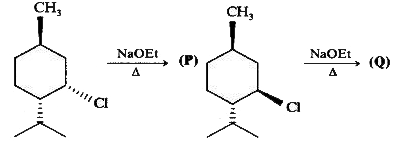In the following reaction, compound Q is obtained from compound P via an ionic intermediate.

What is the degree of unsaturation of Q?
The correct Answer is:18
Topper's Solved these Questions
- JEE (ADVANCED ) 2020Book:JEE ADVANCED PREVIOUS YEARChapter:JEE (ADVANCED ) 2020Exercise:SECTION -II
Explore 5 Videos
- MOCK TEST 2022Book:JEE ADVANCED PREVIOUS YEARChapter: MOCK TEST 2022Exercise:QUESTIONS
Explore 14 Videos
- JEE ADVANCEDBook:JEE ADVANCED PREVIOUS YEARChapter:JEE ADVANCEDExercise:CHEMISTRY SECTION - IV : Matric Match Type
Explore 2 Videos
Similar Questions
In thermodynamics, the P−V work done is given by
w=−∫dVPext.
For a system undergoing a particular process, the work done is ,
w=−∫dV(RTV−b−aV2)
The equation is applicable to a
View SolutionWhich green coloured compound of chromium is formed in borax bead test ?
View SolutionMatch the transformation in column I with appropriate options in column II

View SolutionWhat is the degree of unsaturation in compound (x).
View SolutionNitric acid can be obtained from ammonia via the formation of intermediate compounds
View SolutionIn the following compound - The degree of unsaturation (DBE) in the given compound is :
View SolutionConsider the following reaction sequence

The compounds P and Q are :
View SolutionNitric acid can be obtained from ammonia via the formation of the intermediate compounds
View Solutionएक आयनिक यौगिक P धनायनों तथा Q ऋणायनों से निर्मित है |
View SolutionNitric acid can be obtained from ammonia via the formation of the intermediate compounds
View SolutionDegree of unsaturation in the following compound is :

View SolutionNitric acid can be obtained from ammonia via the formation of the intermediate compounds
View SolutionNitric acid can be obtained from ammonia via the formations of the intermediate compounds
View SolutionConsider the following reaction:

Identify product (P) and (Q) from the folowing compounds:

View SolutionConsider the following reaction: Identify product (P) and (Q) from the folowing compounds:
View Solution


